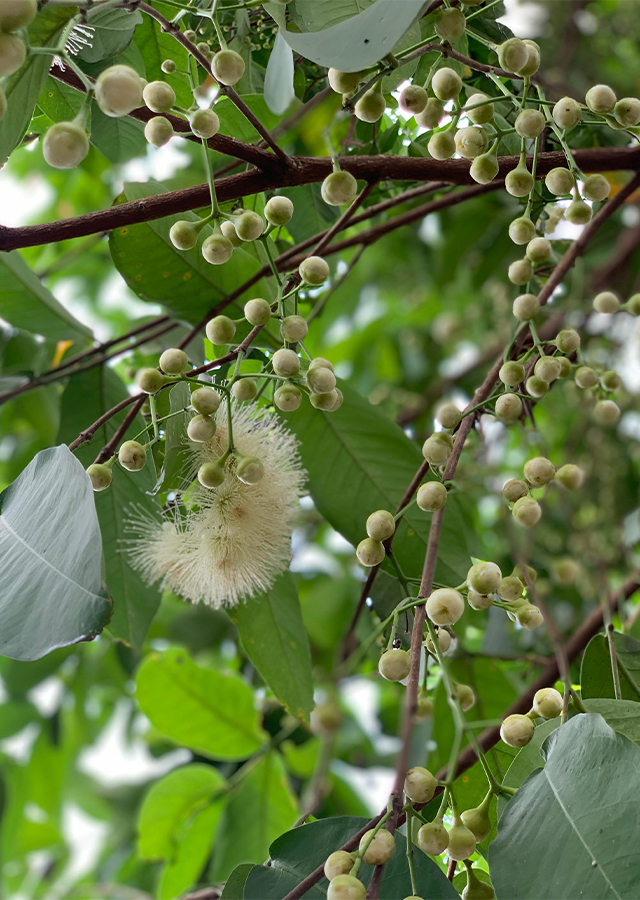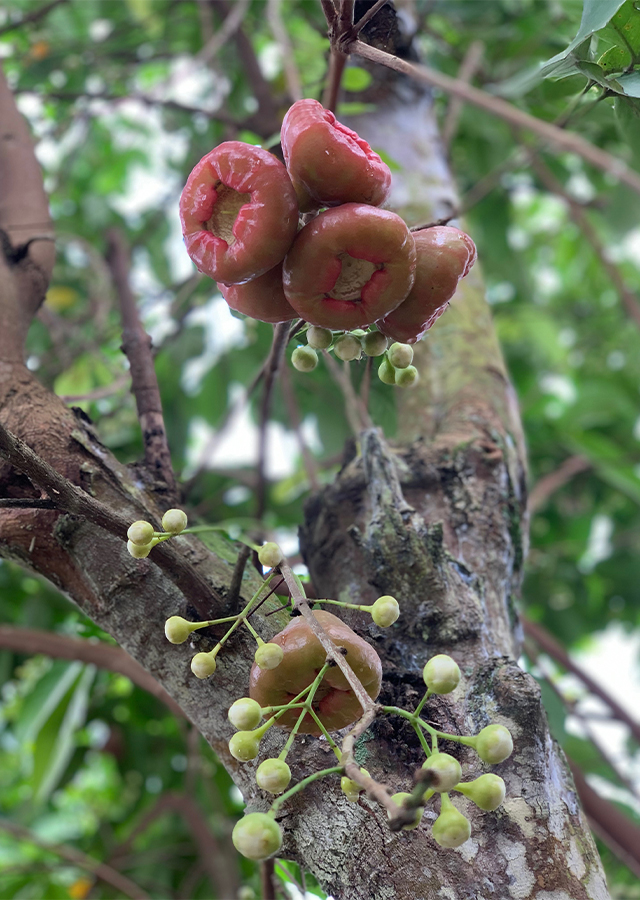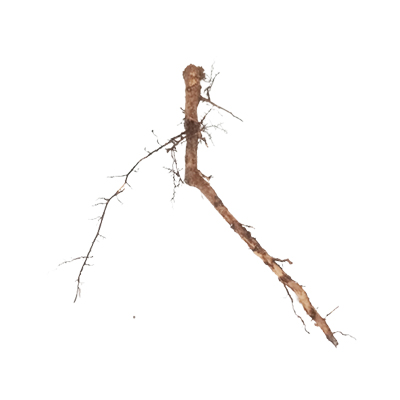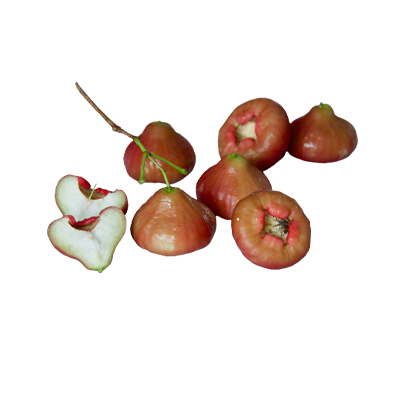Water Apple
Syzygium aqueum (Burm.f.) Alston
Myrtaceae
Location in our garden
Orchard



Synonym
Cerocarpus aqueus (Burm.f.) Hassk.
Eugenia aquea Burm.f.
Eugenia callophylla (Miq.) Reinw. ex de Vriese
Habitus
Trees. An evergreen shrub or small tree with a small crown, grows 6-10 m tall
Part Used
Bark
Fruit
Stem
Growing Requirements
Full Sunshine
Habitat
Terrestrial
Overview
Water apple is native to South East Asian countries and to certain tropical regions of India. Most from Philippines, Indonesia, and Malaysia. The tree is often cultivated for its fruit in home gardens, where it is planted along driveways and paths.
Vernacular Names
Shui lian wu (Chinese), Jambosier d'eau (French), Wachsjambuse (German), Mizu renbu (Japanese), Jambu air (Indonesia, Malaysia), Chom phu pa (Thai).
Agroecology
The trees are planted in fairly moist tropical lowlands at elevations up to 1,200 m. They grow best in areas with a fairly long dry season. Plants are not tolerant of temperatures going below freezing. Grows vigorously in poor, alkaline soils, though it prefers better conditions. Prefers a light, well-drained, mildly acid soil. Requires a reliable water supply, it is often planted along streams or by ponds. Seedling plants commence bearing fruit when about 7-8 years old, whilst layered plants can fruit in 3-4 years.
Morphology
- Stems - woody, short with branching occuring at about 1 meter. Bark is brown and cracked.
- Leaves - elliptic (5-23 cm long, 2.5-13 cm wide) with very short petioles.
- Flowers - loosely arranged in small terminal or axillary clusters of 3-7. The bisexual flowers carry a large number of long stamens that give the flowers a fluffy appearance.
- Fruits - pear-shaped berries (5 cm long). The apex has a shallow cavity that is partially covered by 4 fleshy sepals. The skin is shiny, thin and waxy, while the flesh is white, juicy and crisp.
- Seeds - often seedless, but sometimes have 1-4 small seeds.
Cultivation
- Seeds lose their viability quickly and should be sown fresh from the fruit.
- Vegetative propagation is by air layering (a simple method of propagation), cuttings root, and budding.
- Syzygium aqueum loves fertile planting media, contains a lot of organic material, drainage and aeration in good soil and loose. To obtain soil conditions that have good draenase and aeration of soil we can use wood charcoal as a material to create air and water circulation in the soil.
Chemical Constituents
Flavonoids, alkaloid, tannins, glycosides, formic acid, tartaric acid, phenolic, β-carotene, ascorbic acid, pro anthocyanidins, essentiatl oil, steroid, terpenoid.
Traditional Medicinal Uses
Medicinal Uses
- It has medicinal properties and uses such as digestive, anti-diabetic, astringent, anti-helminthic, anti-inflammatory, antioxidant and antibacterial properties.
- It is used for fights free radical damage, bolsters immune function, reduced risk of stroke and boots good HDL cholesterol.
- Syzygium aqueum leaf extracts are used extensively as skin care products, possesses UVB-blocking ability.
Traditional Uses
- In Hawaii, an astringent bark decoction is used to treat thrush.
- In Malaysia, powdered dried leaves used to treat cracked tongue. Roots used to relieve itching and to reduce swelling.
- In Malaysia and Indonesia as well as in ancient Indian folk tradition, it is customary to serve a freshly prepared watery rose apple salad to women post childbirth.
- The dried leaves are used as a treatment for malaria and pneumonia. An infusion of the leaves is used in the treatment of stomach aches and dysentery.
Part Used
Reference Sources
- Fern, Ken. (2014). Useful Tropical Plants. Syzygium aqueum (Burm. f.) AlstonL.http://tropical.theferns.info/viewtropical.php?id=Syzygium+aqueum. 11-02-2021.
- National Parks (No date). Flora and Fauna Web. (2019). Syzygium aqueum (Burm. f.) Alston. https://www.nparks.gov.sg/florafaunaweb/flora/3/1/3153 20/02/2021
- Stuart Xchange. (2015). Philippines Medicinal Plants. Syzygium aqueum (Burm. f.) Alston. http://stuartxchange.com/Tambis 11-02-2021.
- Sagala E., Sihombing H., Agustini F., Amanah D., Sembiring D.D., and Harahap D.A. 2017. Analysis of Consumer on Syzygium aqueum in North Sumatera, Indonesia. IOSR Journal of Economic and Finance 8(5):44-48



